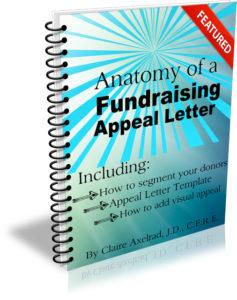 You want to raise money with your fundraising appeal, right?
You want to raise money with your fundraising appeal, right?
Guess what?
However you feel when you sit down to write is how your readers will feel when they sit down to read.
Feeling anxious? Unprepared? Bored?
Your feelings come through in your writing. Or not.
So… first put a smile on your face! Think about what inspires you about your mission. What are you passionate about? What drew you here and keeps you here?
Passion is contagious.
You can do this – it’s just like talking to a friend about how important your cause is.
Yup. Your donor is your friend.
Talk to them exactly that way.
Becoming a writer is about being conscious.
“When you’re conscious and writing from a place of insight and simplicity and real caring about the truth, you have the ability to throw the lights on for your reader.”
– Ann Lamott
7 Key Secrets + 16 Blooming Tips to Appeal Success
1. Know Your Message
Sometimes annual appeals are the equivalent of “Well, it’s annual appeal time again.” That’s about process, not project. Donors don’t care about process; only you do. If you don’t feel what you have to say is critically important on an existential level, don’t expect your donors to feel that way either.
Sometimes I ask clients what would happen if their fundraising appeal didn’t succeed. And sometimes they say “Well, then we’d raise less money.” “And then what?” I ask. “Well, there’d be some things we couldn’t do.” “And then what?” I ask. “I don’t know; I guess we’d manage.” These folks don’t have a good fundraising offer. They haven’t clearly defined a problem, suggested a reasonable solution, and invited the donor to be a part of that solution. They’ve simply suggested sending money would be “nice.”
 TIP 1: Look critically at the subject of your last appeal. Does it sound like you know why you’re writing? Does it sound like you know who you’re writing to? If not, you’re likely writing on auto-pilot, talking at your donor rather than to them. You’re likely writing about what you care about, not what they care about. Or maybe it’s not even clear there’s actually something you care about. It’s just a bunch of words on paper. Sound and fury, signifying nothing. You’re writing unconscious.
TIP 1: Look critically at the subject of your last appeal. Does it sound like you know why you’re writing? Does it sound like you know who you’re writing to? If not, you’re likely writing on auto-pilot, talking at your donor rather than to them. You’re likely writing about what you care about, not what they care about. Or maybe it’s not even clear there’s actually something you care about. It’s just a bunch of words on paper. Sound and fury, signifying nothing. You’re writing unconscious.
2. Know Your Audience
This should be a no-brainer. How can you write to someone if you know nothing about their interests? The fundamental secret that underlies all donor-centric fundraising is this: show your donor you know them.
How do you get to know them?
The best way is not to assume or guess.
Begin with facts in your database (age, gender, geography, profession, gift designation).
Then think about what else you’d like to know about them in order to make them a compelling fundraising offer they won’t be able to refuse.
Would it help to know something about their interests? Their values? Their initial reason for connecting with you?
 TIP 2: Ask your donors about themselves. Create a mailed survey or pick up the phone to get answers to your questions. Design questions so you can better understand your donors’ values. All philanthropy is based on a value-for-value exchange.
TIP 2: Ask your donors about themselves. Create a mailed survey or pick up the phone to get answers to your questions. Design questions so you can better understand your donors’ values. All philanthropy is based on a value-for-value exchange.
Don’t ask too many questions or you’ll depress response.
Ask a mix of questions to collect demographic and psychographic data.
Ask open-ended questions to get qualitative information.
— Why did you first give here?
— Why do you continue giving here?
— What do you like most about what we do?
— What do you like most about the information you receive in our newsletter/blog?
 TIP 3: Create personas or donor identities. Personas are a classic marketing tool to summarize the characteristics of key audience members so you can picture them. “Suzy Soccer Mom.” “Bob Business Entrepreneur.” “Wanda Widow.” Personas help you create a mental picture of the folks you’re writing to so you can write a slightly different appeal to Suzy than you do to Wanda. Take care not to overgeneralize however. The trend is moving towards segmenting lists more by how people self-identify. Take a look at interests and values expressed when you asked donors about themselves via survey, interview or any other means. You may also find different segments (e.g., monthly donors; major donors; online donors; tribute donors; event donors) have distinct traits; you may therefore want to approach them differently.
TIP 3: Create personas or donor identities. Personas are a classic marketing tool to summarize the characteristics of key audience members so you can picture them. “Suzy Soccer Mom.” “Bob Business Entrepreneur.” “Wanda Widow.” Personas help you create a mental picture of the folks you’re writing to so you can write a slightly different appeal to Suzy than you do to Wanda. Take care not to overgeneralize however. The trend is moving towards segmenting lists more by how people self-identify. Take a look at interests and values expressed when you asked donors about themselves via survey, interview or any other means. You may also find different segments (e.g., monthly donors; major donors; online donors; tribute donors; event donors) have distinct traits; you may therefore want to approach them differently.
3. Use Your Audience’s Words
When you mirror people’s own language, they’re able to see themselves in what you do.
If you do it right, they’ll see the person they want to be. Your hero!
Use what you know about your audience from survey questions or phone conversations. Look for phrases or statements that tend to recur.
When I worked for a comprehensive social services agency, the words we commonly heard when we asked folks to select an adjective to describe us were “caring,” “compassionate,” “community” and “necessary.”
One of my clients, a theater company, found their most common comments in Yelp reviews were “quality” and “intimate.”
What great ways to position the uniqueness of these missions and what terrific words to use in fundraising appeals, donation landing pages, newsletters, blogs and social media!
When we write without thinking about or using our donors’ words, we tend towards braggadocio. We use lots of data to boast about how many people we serve, how we’re the biggest and best, and so forth. Do you enjoy it when people just talk on and on about themselves and how great they are? That’s the opposite of donor-centered communication.
 TIP 4: Draw words that will resonate with your supporters from surveys, thank you letters, phone calls, events and daily conversations. Keep a notebook at your desk, and every time you realize you’re hearing a word repeatedly, add it to the list. This helps you to be conscious of what’s already in your donor’s head, enabling you to make your copy more relatable.
TIP 4: Draw words that will resonate with your supporters from surveys, thank you letters, phone calls, events and daily conversations. Keep a notebook at your desk, and every time you realize you’re hearing a word repeatedly, add it to the list. This helps you to be conscious of what’s already in your donor’s head, enabling you to make your copy more relatable.
4. Create a Sense of Urgency
Your donor needs a reason to give NOW, and to give to YOU rather than someone else.
Put your appeal into a current context. What’s happening in the world that’s top of mind for your donors?
Sprinkle the sense of urgency throughout your letter. Don’t wait until your final call to action to say “Please give today.” The “why” should begin your appeal, and then permeate all through your writing.
 TIP 5: Save appeals you receive that move you to quick action. If you haven’t begun your own “swipe file,” now is a good time to start. I suggest filing them according to category. Such as (1) great outer envelope; (2) smoking remit piece; (3) stong use of P.S.; (4) compelling photo and caption; (5) killer opening line; (6) good use of testimonial, and (7) moving, emotional language. And yest, of course, have an urgency file. How did they create that urgency? Why did it work?
TIP 5: Save appeals you receive that move you to quick action. If you haven’t begun your own “swipe file,” now is a good time to start. I suggest filing them according to category. Such as (1) great outer envelope; (2) smoking remit piece; (3) stong use of P.S.; (4) compelling photo and caption; (5) killer opening line; (6) good use of testimonial, and (7) moving, emotional language. And yest, of course, have an urgency file. How did they create that urgency? Why did it work?
 TIP 6: Try one of these urgent calls to action:
TIP 6: Try one of these urgent calls to action:
— Your gift will be doubled if you give before [deadline]
— Our doors will close unless we hear from you before [deadline]
— Someone is killed by gun violence every minute. Please give NOW.
— The cold of winter is upon us. Please get people into a warm shelter TODAY.
 TIP 7: Put your urgent reason to give in your P.S. It’s one of the first things people read, and will capture people’s attention. A good P.S. will draw people in to read the rest of the letter. An urgent reason to give in the P.S. may even compel people to give without even reading the rest of the letter!
TIP 7: Put your urgent reason to give in your P.S. It’s one of the first things people read, and will capture people’s attention. A good P.S. will draw people in to read the rest of the letter. An urgent reason to give in the P.S. may even compel people to give without even reading the rest of the letter!
5. Make it Easy to Comprehend and Digest
Write at a 6th-grade level.
People today are challenged for time. They skim. Short words and paragraphs make skimming possible.
 TIP 8: Use the Flesh-Kincaid test (you can find this in your Word program). Write colloquially (i.e., how you would talk). Read your letter out loud, and take out anything over which your tongue trips. It’s okay to use contractions, one-word sentences, and to begin sentences with conjunctions. That’s what we do when we talk.
TIP 8: Use the Flesh-Kincaid test (you can find this in your Word program). Write colloquially (i.e., how you would talk). Read your letter out loud, and take out anything over which your tongue trips. It’s okay to use contractions, one-word sentences, and to begin sentences with conjunctions. That’s what we do when we talk.
 TIP 9: Dictate your appeal by using the voice tool on your computer or cell phone. You’ll find everything flows more naturally, and your letter will come across like you speak. Casual and friendly rather than formal and stilted. I like Dragon Naturally Speaking (Windows only), which comes in a variety of versions to conform with your needs and budget. There are free alternatives.
TIP 9: Dictate your appeal by using the voice tool on your computer or cell phone. You’ll find everything flows more naturally, and your letter will come across like you speak. Casual and friendly rather than formal and stilted. I like Dragon Naturally Speaking (Windows only), which comes in a variety of versions to conform with your needs and budget. There are free alternatives.
 TIP 10: Use simple design. Don’t clutter up the page with too much dense text. Go for plenty of white space. This means short paragraphs. Indent the paragraphs to give people’s eyes a natural rest. Help folks know what’s importat by using headlines, sub-heads, underlines and bullets. And don’t forget to use a compelling photo, or photos, that tell a story.
TIP 10: Use simple design. Don’t clutter up the page with too much dense text. Go for plenty of white space. This means short paragraphs. Indent the paragraphs to give people’s eyes a natural rest. Help folks know what’s importat by using headlines, sub-heads, underlines and bullets. And don’t forget to use a compelling photo, or photos, that tell a story.
 TIP 11: A picture is worth 1000 words. The emotional, intuitive right brain is less interested in details than the total picture. Look at the photos you’ve used in past appeals. Do they stand on their own? Do they stand on their own once you add a brief caption? If not, find something better.
TIP 11: A picture is worth 1000 words. The emotional, intuitive right brain is less interested in details than the total picture. Look at the photos you’ve used in past appeals. Do they stand on their own? Do they stand on their own once you add a brief caption? If not, find something better.
 TIP 12: Re-read your letter. How might you add headlines, subheads and bullets to break up the text and make it more readable? Now look at how you might make judicious use of bold face, italics and underlines to call out important text. I like to consider my letter to be a series of smaller letters within the one big letter. If folks read only the headlines and subheads, they’ll get the gist. If they read only the boldface, they’ll get the gist. If they read only what’s underlined, they’ll get the gist. Since you never really know what parts of the letter your reader will read, it’s good to hedge your bets and repeat your core message more than once.
TIP 12: Re-read your letter. How might you add headlines, subheads and bullets to break up the text and make it more readable? Now look at how you might make judicious use of bold face, italics and underlines to call out important text. I like to consider my letter to be a series of smaller letters within the one big letter. If folks read only the headlines and subheads, they’ll get the gist. If they read only the boldface, they’ll get the gist. If they read only what’s underlined, they’ll get the gist. Since you never really know what parts of the letter your reader will read, it’s good to hedge your bets and repeat your core message more than once.
6. Overcome Writer’s Block
Sometimes you sit down at your desk and your mind goes blank. You just can’t get started. What to do to overcome this?
 TIP 13: Talk to someone else about what you want to say before you sit down to write. It will help you crystallize your thinking. And sometimes just getting your words out of your head and into the open helps.
TIP 13: Talk to someone else about what you want to say before you sit down to write. It will help you crystallize your thinking. And sometimes just getting your words out of your head and into the open helps.
 TIP 14: Find a quiet space where you can be uninterrupted. When your mind is on a million other things, you’re not likely to do your best work. Try to block out some time on your schedule too, so you aren’t doing anything else. Including checking your phone and email.
TIP 14: Find a quiet space where you can be uninterrupted. When your mind is on a million other things, you’re not likely to do your best work. Try to block out some time on your schedule too, so you aren’t doing anything else. Including checking your phone and email.
 TIP 15: Get out in the field before you sit down to write, especially if it’s been a while since you visited your programs. If your work doesn’t lend itself to field visits, go talk to the folks who have the most interaction with those who benefit from your programs and services. Learn how your organization made a real difference in people’s lives. Or simply go through old files of thank you letters from clients (ask your program staff). Or re-watch some of your own video stories. Before you can inspire others, you must fill up your own inspiration cup.
TIP 15: Get out in the field before you sit down to write, especially if it’s been a while since you visited your programs. If your work doesn’t lend itself to field visits, go talk to the folks who have the most interaction with those who benefit from your programs and services. Learn how your organization made a real difference in people’s lives. Or simply go through old files of thank you letters from clients (ask your program staff). Or re-watch some of your own video stories. Before you can inspire others, you must fill up your own inspiration cup.
7. Communicate for Understanding by Avoiding Jargon
It takes a lot of awareness — and practice — to avoid falling into the jargon pit. It’s important you do so, however, as jargon stops folks dead in their tracks. When people have little time to read your letter, they’re not going to keep reading if you make them struggle. Acronyms are bad. Annoying words are bad.
 TIP 16: Always ask yourself:
TIP 16: Always ask yourself:
— Is there a simpler word?
— Is there a word that has more impact?
— Is there a word that’s more specific?
— If I took this word out, would the meaning be just as clear? More clear?
— Does this word unnecessarily (or stereotypically) categorize someone?
CLOSING
A good fundraising appeal is a conversation on paper, not a monologue testifying to your greatness. Keep your donor’s perspective at the forefront of your writing. Consider what they care about, what they know or don’t know about what you do, and what might move them to answer your call to action.
People are busy. They don’t have lots of time, so many will skim your appeal. That being the case, your words should be powerful. Every single one of them.
I hope you won’t simply read this article and delete it. Print it out, put an asterisk next to a few of the items that resonate with you, and commit to doing something new that will improve your messaging and writing moving forward. Now… go make your next appeal blossom!
Want More Help Writing Your Appeal?
 Grab my Anatomy of a Fundraising Appeal Letter + Sample Template. This is a simple, yet incredibly thorough, 62-page step-by-step guide to crafting a killer appeal letter or email appeal. Because writing a compelling fundraising letter can be tricky. It’s not the same kind of writing as a brochure, annual report or grant proposal.
Grab my Anatomy of a Fundraising Appeal Letter + Sample Template. This is a simple, yet incredibly thorough, 62-page step-by-step guide to crafting a killer appeal letter or email appeal. Because writing a compelling fundraising letter can be tricky. It’s not the same kind of writing as a brochure, annual report or grant proposal.
But it’s not rocket science – it’s something you can easily learn. It’s just not something most of us are taught.
And that’s where this nifty e-Guide comes in! Don’t find it helpful? All Clairification guides come with a 30-day, no-questions-asked, 100% refund guarantee. If you’re not happy, I’m not happy.
Photo of San Francisco pandemic-era street art.




